Saturday, April 02, 2005
JPL has released the weekly Cassini Status report. Perhaps the most significant news in this report is the item on the "Tethys tweak", mentioned here last week. This week, the tweak was approved. This change means that Cassini's 33,000 km of Tethys on September 24 is now a 1500 km targeted encounter. In addition, the 1000 km targeted encounter of Hyperion on that orbit is now at 500 km. This is great news though it comes at the cost of a RADAR observation of Saturn's atmosphere.
The Death of Pope John Paul II
I try not to delve off-topic, and since I started this blog, I've managed to accomplish that. I have to break from that today. About an hour ago, Pope John Paul II died at the age of 84. I am a Catholic and John Paul II is the only pope I have known having been made pope 5 years before my birth. No matter my stage in life or what's going on in the world, every Sunday, prayers were made on behalf of Pope John Paul II during mass. Even if you are not Catholic or religious of any sorts, no doubt John Paul II was still an important man who was perhaps most instrumental in ending Communism in Eastern Europe. He, unlike almost all of his predecessors, reached out to people, be they the poor of Africa and Latin America, or people of other faiths, bridging the gap between rich and poor, Jew, Muslim, and Christian. He believed that God loved them all and respected the universal right of human dignity. Today we have lost that man. But, for those of faith, he is now in a better place without pain, thanks to his wonderful works on Earth.
Thank you for indulging me on this. This is a very emotional event for me and I needed to get this off my chest. Thank you.
Thank you for indulging me on this. This is a very emotional event for me and I needed to get this off my chest. Thank you.
More T4 Raw images
Looks like the rest of the T4 Titan images are now available on the JPL Raw images page. Again, sorry for delay. Given the uptick in readership yesterday, Iguess people were looking forward to those images. here are a few new highlights. Obviously these are all unprocessed. You will just have to wait a little while longer for the processed images.
- 80-km wide crater seen by RADAR now seen by ISS (dark circular patch in the middle of a bright patch near center left)
- Bright material jutting out of bright island in H
- More terrain seen by RADAR last month
- Northwestern "H" (west of previous images)
- Backscattered Haze structure
- Tectonic features (also seen here from T0)
- Islands in the H region
- The "VIMS Palimpset"
- Titan crescent
Friday, April 01, 2005
T4 Images
Images should start coming down in an hour and a half (10:30 am MST). I will use this post to link to best raw images here.
UPDATE: 11:15pm MST Images are starting to show up on the JPL Raw images. Discuss amongst yourselves.
North is to the left in all surface images.
UPDATE: 11:15pm MST Images are starting to show up on the JPL Raw images. Discuss amongst yourselves.
North is to the left in all surface images.
Exclusive: Life on Titan?
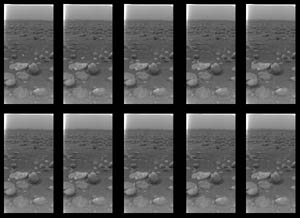
Update: okay, you caught me. Happy April Fools Day everyone!!
I have just recieved this image from a DISR team member who wished to remain nameless. This shows 10 images taken using the Side-looking imager on Huygens while it was on the surface. These images have thus far not been released to the public. During processing of these images, DISR team members noticed slight movements within some of the surface frames. At first this was brushed off as a processing artifact or a compression artifact, but the type of movement seen could not be removed with further processing. The first interpretation was that DISR maybe seeing evidence of fluid flow at the landing site. But the GCMS results showed that there could not have been standing liquid on the surface and certainly not enough to explain the anomaly's appearance on the stone less than a meter away. Based on the behavior of the feature, one interpretation that has been put forth and that will be presented in two weeks at an ESA Press Briefing, is that the bright feature seen in these SLI images is some form of life on the surface of Titan. Based on the shape and behavior, it appears that the creature maybe some kind of worm, either attracted to the heat given off by Hugyens or frightened of it, given both its approach to the probe and its seeming hiding within the crack of a stone a meter away. In the last frame, two other bright spots appear, perhaps suggesting a number of creatures.
If confirmed through further processing, this could be one of the largest discoveries in the history of human exploration of the solar system.
Thursday, March 31, 2005
Rhea's Ray Crater
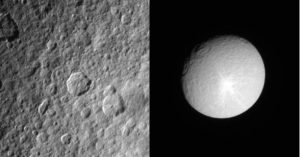
One of the features in the new set of Rhea images is a very prominent ray crater. The full ray system is better seen at lower phase angles, like this opnav image from last week. Ray systems often denote fresher craters where the ejecta and secondary craters have not been "eroded" by space weathering. Famous ray craters include Tycho and Copernicus on the Moon, Zunil on Mars, and Cassandra on Dione (lower left). Cassini imaged Rhea's major ray crater at 900 m/pixel on this encounter.
Astrobiology Magazine: On Ammonia and Astrobiology
Astrobiology Magazine has posted the final installment of their series of edited transcripts of a talk Dr. Jonathan Lunine gave here at the University of Arizona in late January. This installment covers the role ammonia may have played in Titan's geology and internal structure.
Thanks to imran at the Unmannedspaceflight.com forum for the heads up.
Thanks to imran at the Unmannedspaceflight.com forum for the heads up.
Medium Range Rhea Images
Images of Rhea taken at medium range (~150,000 km) are now up on the JPL Raw images page. Not much to write home about..
What I notice about Rhea is just how old it looks. All the creates look degraded, their rims are rough and their floors look almost filled with rubble. Not to mention all the craters look polygonal rather than circular.
UPDATE: DEChengst over at the UnmannedSpaceflight.com forum has posted a nice. 9-image mosaic of Rhea using images taken on this encounter.
What I notice about Rhea is just how old it looks. All the creates look degraded, their rims are rough and their floors look almost filled with rubble. Not to mention all the craters look polygonal rather than circular.
UPDATE: DEChengst over at the UnmannedSpaceflight.com forum has posted a nice. 9-image mosaic of Rhea using images taken on this encounter.
Epimetheus Up-Close
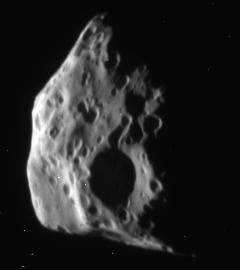
Just in on the JPL Raw images page is this view of Epimetheus. This is the best image ever taken of this small inner satellite. Immediately I am reminded of the distant images of Phoebe in terms of the appearance of craters and the distribution and amount of cratering. From the Wikipedia article on Epimetheus, this moon is 119 km across (half the size of Phoebe). It is a very porous body with a density of 0.61 g/cm3 (remember ice has a density of 0.96 g/cm3). Epimetheus is almost co-orbital with the satellite Janus. Every 4 years, they switch orbits, with one orbiting 100 km closer to Saturn than the other. The next swap is scheduled for next February. I saw that Phil Stooke posted a few comments here yesterday so if he comes back today, maybe he can post his comments on these images of Epimetheus.
New Mimas Image: Moon Wears a Scar
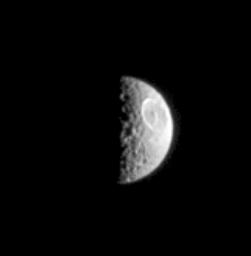
CICLOPS has released a newly processed view of Mimas in reflected ultraviolet light. This view emphasizes the crater rim of Herschel, the largest crater on Mimas.
Wednesday, March 30, 2005
Rhea Images coming up
New images of Rhea, taken from a distance of 120,000 km, should be showing up on the raw images page overnight Mountain Standard Time. The view will primarily be of the leading hemisphere of Rhea. I will post the most interesting images here from the JPL Raw Images tomorrow morning. I will admit though, Rhea is now my least favorite of the Saturnian satellites so please excuse me for not getting overly excited but hey, any new images where a satellite completely fills the field of view is interesting.
Planetary Society on T4
The Planetary Society website has an article on the upcoming T4 flyby. To be honest, they don't present much more info than I already have but it is still worth a look I guess.
Raw Images of the Day
Since I've been gone a few days, here is a super sized "Raw Images of the Day":
- Dione and the Rings. This is great view of Dione showing the more cratered hemisphere of this particular moon.
- Trailing hemisphere of Enceladus (should show up soon)
- Herschel and the south pole of Mimas
- Crescent of Iapetus
- Clear filter view of Titan's Trailing hemisphere
- Another look at Enceladus
- Penelope crater on Tethys. Not sure why that crater is always so prominent, maybe the margins are steeper or the crater is deeper, not sure.
- Enceladus and the Rings
- Ray crater on Rhea
- Ithaca Chasma on Tethys
- More Enceladus
- Mimas with Rings
- Tethys (with Penelope crater) and Enceladus
- Cratered Mimas
- Titan with Rings
- Craters on Dione
- A better view of an Iapetus crescent
- Yet more Enceladus
- Wispy Terrain on Rhea
- Wispy Terrain on Dione
T4 Coverage Plot
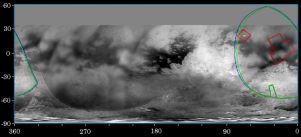
CICLOPS has released a coverage plot showing the regions that will be imaged by ISS during tomorrow's flyby of Titan. Frankly this plot took far longer to create than anticipated but here it is regardless. Obviously, the region that will be covered is on the opposite hemisphere as the views seen in Ta in October, Tb in December, and T3 last month. The main attraction of this flyby is that we will get coverage over much of the eastern portion of the T3 SAR swath, including an 80-km crater and some high resolution coverage near the C/A point in the T3 SAR swath (red and yellow boxes in the upper right of the coverage area.
See the T4 post below for more information on this encounter.
Tuesday, March 29, 2005
Alive and Well
Just letting everyone know, I am alive and well, I've just been in Flagstaff for a workshop at the USGS, where apparently wireless networks are forbidden, so I was unable to connect.
I guess I could have with today's more hands-on session, but to be honest, I was way to busy.
Following up on the report below on the "Tethys tweak", I have no new word on whether it has been approved, but apparently the tweak is the result of the desire to avoid the E-ring as much as possible. In a possible tweak to avoid the ring, a closer Tethys encounter in September shook out.
I guess I could have with today's more hands-on session, but to be honest, I was way to busy.
Following up on the report below on the "Tethys tweak", I have no new word on whether it has been approved, but apparently the tweak is the result of the desire to avoid the E-ring as much as possible. In a possible tweak to avoid the ring, a closer Tethys encounter in September shook out.
New Epimetheus Image: Big Boulder
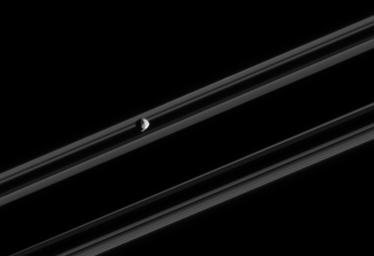
CICLOPS has released this newly processed view of Epimetheus, a small, inner moon of Saturn, and Saturn's rings. Like yesterday's image, this view elegently displays Epimetheus non-spherical shape.
Monday, March 28, 2005
New Epimetheus Image: Epimethean Profile
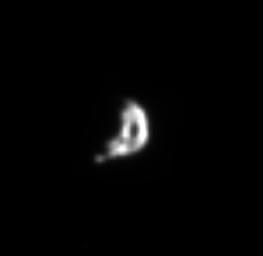
CICLOPS has released this newly processed view of Epimetheus, a small, inner satellite of Saturn. Epimetheus is co-orbital with Janus, shown late last week. This view reveals rugged terrain near the terminator.

